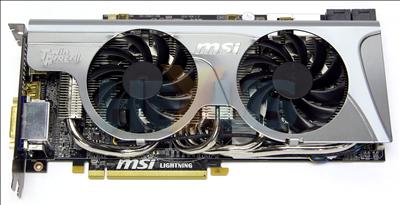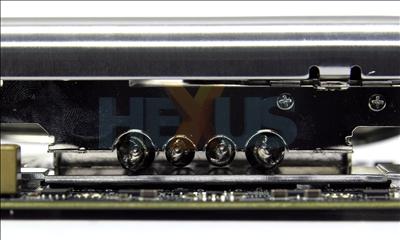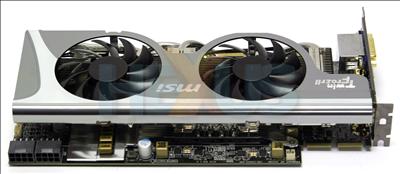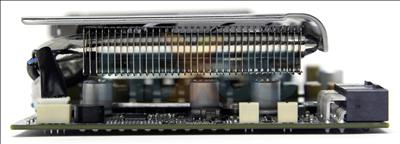How make to make the best HD 5870 around?
The R5870 Lightning, set to etail for £360, is the culmination of MSI's custom-designed graphics-card thinking. Borrowing heavily from the GeForce GTX 275 Twin Frozr OC and, more recently, the HD 5770 HAWK, the card throws the reference design completely out of the window.
Radeon HD 5870, whilst undeniably high-end, isn't the hottest-running GPU around, pulling a maximum 188W under load at stock voltages and frequencies of 850MHz core and 4,800MHz GDDR5 memory.
MSI, however, knows it needs to cater for the enthusiast who will raise both voltage and frequency and has thus slapped a card-wide Twin FrozrII heatsink on top
Connected to the GPU via four heatpipes - two 8mm and two 6mm - and hooked-up to twin 80mm fans, the heatsink is substantial. We like the fact that the PCB-connecting heatsink covers the 1GB of RAM, too.
MSI provides a perfunctory increase in stock frequencies; the R5870 Lightning ships with a 900MHz core, but keeps the memory at a reference-matching 4,800MHz. We know the card can be pushed higher, so it's somewhat confusing as to why MSI's been conservative - especially on the RAM.
Here's the reason the PCB is irregular. The Lightning uses a 15-phase PWM (power regulation) for stable juice as the frequency/voltage is cranked up. Overkill? For sure, as the reference uses a 7-phase, yet overkill is what the card is all about.
Part of the company's 'Military Class' program, R5870 Lightning also has Hi-C, all-solid capacitors and solid-state chokes. The design is good insofar as the twin FrozrII fans help keep all components cool, blowing down on the hot-running components.
Set to 'auto' by default the fans spin at 2,200rpm when the GPU is idling and run up to 3,700rpm when under extreme load. These numbers correlate to a noise profile that's similar to the reference card's - one that can be heard in a quiet system - when little or no GPU activity, but a pretty noisy card when going full-tilt - certainly louder than either the Sapphire or PowerColor pre-overclocked models.
Annoying, the thin aluminium section surrounding the fins begins to vibrate when fan-speed rises to >3,500rpm. The instances of this happening are rare, and we have to generate such load by using a GPU-bashing application such as FurMark, but it's something that shouldn't happen.
Want power? How about dual side-mounted 8-pin connectors. The power-sucking Radeon HD 5970 makes do with a 6-pin-and-8-pin arrangement, by the way, and we'd be impressed if anyone could put 375W through this board.
Keeping the enthusiast-friendly theme going, MSI also includes two voltage-checking points - Vcore and Vmem - next to the power connectors, along with a third - VDDC1 - by the CrossFireX connectors. Multimeter-connecting probes are supplied in the bundle.
Going the extra mile, the R5870 Lightning has gold-plated connectors on the rear. The combination of outputs are one of the few reference-like features on the card.
The PCB's a little shorter than reference, coming in at 258mm, but measures 116mm in height, compared to 98mm of most other HD 5870s. Weighing in at 753g it is 200g lighter than the generic model, as supplied by AMD.
Summary
MSI's paid a significant amount of attention in designing the R5870 Lightning. Shipping with 900MHz core and 4,800MHz memory, it's ripe for overclocking. Now if only the fans weren't quite so loud under load...


















